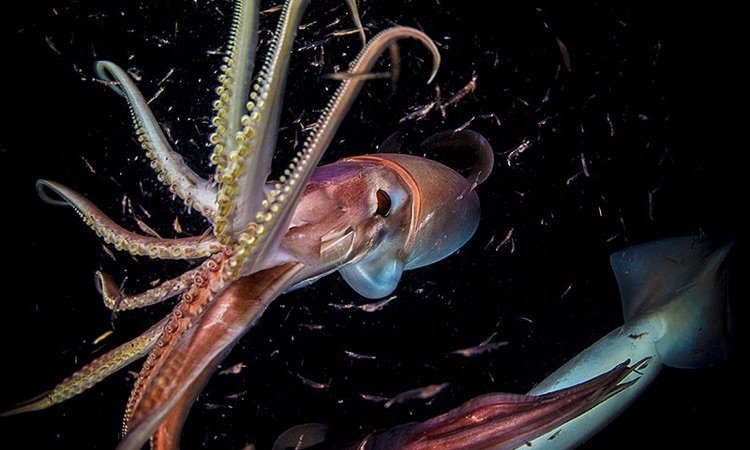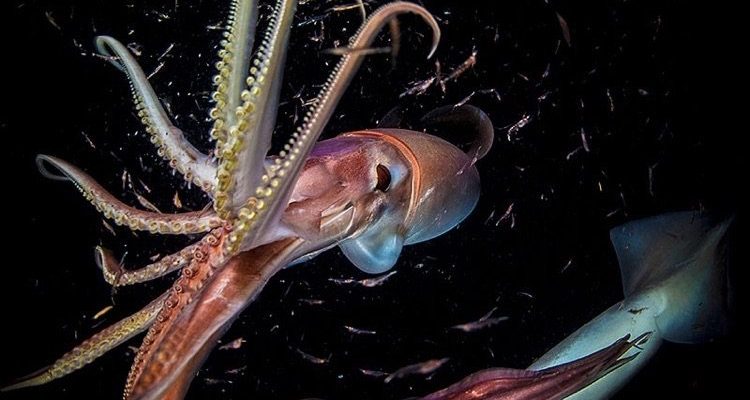
Humboldt squids are found primarily in the Pacific Ocean, but their habitat is quite expansive. From the rich coastline of South America to the deep, mysterious depths of the ocean, these squids thrive in various environments. Understanding where Humboldt squids are found helps us appreciate their role in the marine ecosystem. So let’s dive deep (pun intended) into their world and explore more about their habitats!
Exploring the Pacific Ocean
The Humboldt squid predominantly inhabits the Pacific Ocean, particularly along the coasts of North and South America. Picture a vast blue expanse dotted with fishing boats and wildlife. These squids favor deeper waters where the temperature is just right—generally between 50°F and 68°F (10°C to 20°C). You might be wondering why they prefer these depths. Well, the cooler waters are rich in nutrients, which translates to an abundance of food like fish and other marine life.
These squids are often found near the surface during the night when they come out to hunt. It’s a bit like clocking into a night job, isn’t it? They’re a lot more active after dark, using their stealth and speed to catch prey. This nocturnal behavior helps them evade predators, making nighttime their prime time to thrive.
Coastal Habitats
Along coastlines, Humboldt squids are commonly found in continental shelf areas where the ocean floor rises to meet land. Coastal upwelling zones are their favorite spots. Here, nutrient-rich waters are pulled up from the depths, creating an underwater buffet that attracts not only squids but also various fish and marine mammals.
Let’s paint a picture: imagine vibrant underwater forests made of kelp swaying gently in the currents, with squids weaving through them like dancers. This habitat provides both shelter and hunting grounds. The squids can easily hide among the kelp, ready to launch out at a moment’s notice. What a perfect setting for their energetic hunting style!
Deep Water Dwellers
Beyond coastal areas, Humboldt squids can also be found in deeper waters of the Pacific Ocean. They often venture down to depths of 1,500 feet (about 460 meters) or more. This environment is more mysterious and less explored, filled with bioluminescent creatures that light up the dark waters. It’s almost like an underwater disco party!
In these deeper regions, squids adapt their behavior and diet. With fewer predators and plenty of prey, they get to stretch their tentacles and have an easier time hunting. Yet, the conditions are extreme—think high pressure, low light, and cold temperatures. Humboldt squids are resilient, demonstrating their ability to thrive in various environments.
The Role of Upwelling Zones
One vital aspect of the Humboldt squid’s habitat is upwelling zones—areas where nutrient-rich water rises to the surface. These zones are crucial for their survival, providing a wealth of food and encouraging a thriving ecosystem. Upwelling typically occurs near coastal areas and is driven by winds and ocean currents.
These zones are not just buffet tables for squids; they attract a variety of marine life, from small fish to larger predators. Because Humboldt squids are known for their aggressive hunting, they often dominate these food chains, playing a key role in maintaining the balance of marine ecosystems. This natural cycle reinforces the importance of these habitats, not just for squids but for ocean health as a whole.
Migration Patterns
Humboldt squids are known for their migratory behavior, often traveling vast distances in search of food and favorable spawning conditions. Research shows that they can cover hundreds of miles, following prey availability. This movement isn’t random; squids have a knack for sensing changes in their environment, allowing them to adapt their migration patterns accordingly.
Imagine a road trip without a map, but somehow you know exactly where to go based on your cravings for snacks. That’s similar to how these squids navigate. Their migrations can also be influenced by environmental factors like ocean temperature and currents, which dictate where the best hunting spots are at any given time.
Impact of Climate Change on Habitats
As with many marine species, climate change poses a threat to the habitats of Humboldt squids. Changes in ocean temperatures and acidity can disrupt their food sources and migration patterns. Warmer waters may push squids to deeper areas or further away from their preferred habitats.
Additionally, increased fishing activity impacts their numbers and food supply. As ocean ecosystems become more imbalanced, Humboldt squids could face challenges in finding adequate prey. It’s unsettling to think how these vibrant creatures could be affected by factors beyond their control.
Final Thoughts on the Humboldt Squid’s Habitat
Understanding where Humboldt squids are found opens a window into the incredible diversity of marine life. From the bustling coastlines of the Pacific to the deep ocean depths, these squids adapt and thrive in various habitats. They play a significant role in the oceanic food web, making their preservation vital for healthy ocean ecosystems.
So, whether you’re an aspiring marine biologist or simply someone curious about the ocean, knowing more about these fascinating squids can deepen your appreciation for the underwater world. Next time you hear about the Humboldt squid, you’ll have a treasure trove of knowledge about where they live and why it matters. Isn’t the ocean full of surprises? Remember, every creature, no matter how big or small, plays a role in the grand tapestry of marine life.

